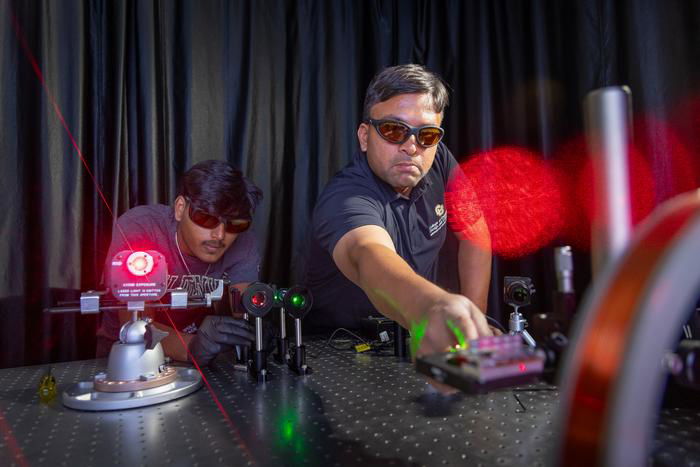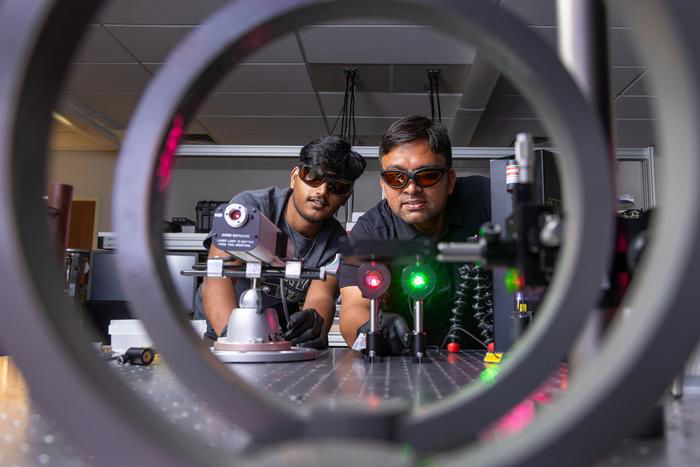A University of Colorado Denver engineer has developed a quantum tool involving extreme plasmons that he believes has the potential to bring about sci-fi technologies, such as gamma-ray lasers and sensors powerful enough to hunt for the multiverse.
According to UC Denver Assistant Professor of Electrical Engineering Aakash Sahai, PhD, his discovery could have a similar impact to previous materials science breakthroughs such as the sub-atomic structure that led to lasers, computer chips, and LEDs.
“This innovation, which is also based on material science, is along the same lines,” Sahai said. “It is very exciting because this technology will open up whole new fields of study and have a direct impact on the world.”
Extreme Plasmons, Electromagnetic Fields, and Sci-Fi Technologies
When engineers need to create extremely high-energy electrical fields for various experiments, ranging from medical applications to probing the very nature of reality, they employ massive, resource-intensive facilities like the Large Hadron Collider at CERN, made famous for its discovery of the Higgs boson, which conveys mass to matter.
According to a press release announcing the discovery, such extreme magnetic fields “power everything from computer chips to super particle colliders that search for evidence of dark matter.” Still exciting electrons in materials so they vibrate at high enough speeds to create such fields is a challenge. Now, Professor Sahai has developed a previously unavailable technique for creating similarly “extreme” electromagnetic fields in a lab.
 Engineering Assistant Professor Aakash Sahai and graduate student Kalyan Tirumalasetty run a test in a laser lab at the University of Colorado Denver. Image Credit: University of Colorado Denver
Engineering Assistant Professor Aakash Sahai and graduate student Kalyan Tirumalasetty run a test in a laser lab at the University of Colorado Denver. Image Credit: University of Colorado Denver
Sahai’s approach, published in Advanced Quantum Technologies, involved creating a silicon-based, chip-like material with unique capabilities. According to the release, due to the activity of a class of quasiparticles called extreme plasmons, the breakthrough material can “withstand high-energy particle beams, manage the energy flow, and allow scientists to access electromagnetic fields created by the oscillations, or vibrations, of the quantum electron gas—all in a space about the size of your thumb.”
Sahai said that because extreme plasmons enable the material to manage the heat flow generated by electron oscillations, samples used in high-energy experiments and applications remain intact and stable. The release stated that this previously unavailable material stability offers scientists a new tool capable of detecting activity and “opens the possibility of shrinking miles-long colliders into a chip.”
While clinical or collider-grade applications remain speculative and likely years in the future, “Manipulating such high energy flow while preserving the underlying structure of the material is the breakthrough,” explained Kalyan Tirumalasetty, a graduate student in Sahai’s lab who worked on the project.
“This breakthrough in technology can make a real change in the world. It is about understanding how nature works and using that knowledge to make a positive impact on the world,” Tirumalasetty said.
Removing Cancer at the ‘Nano-Level’
While CU Denver has already received provisional patents on the technology in the U.S. and internationally, Sahai said that practical applications of his extreme plasmons technique are still likely years away. However, the engineering professor also believes that advanced technologies, which are still confined to science fiction, could finally become viable.
“Gamma ray lasers could become a reality,” Sahai said. “We could get imaging of tissue down to not just the nucleus of cells but down to the nucleus of the underlying atoms.”
Tools with this level of precision would enable doctors and scientists to observe processes at the nuclear level in real time. Sahai said just this single application of his extreme plasmons technique “could accelerate our understanding of immense forces that dominate at such small scales while also leading to better medical treatments and cures.”
“Eventually, we could develop gamma ray lasers to modify the nucleus and remove cancer cells at the nano level,” he added.
Exploring the Fabric of Reality And Hunting for Signs of the Multiverse
Perhaps the most sci-fi sounding application proposed by Sahai and Tirumalasetty was using the extreme plasmons technique to probe the fabric of reality. According to the release, applications of the technique could “help test a wide range of theories about how our universe works—from the possibility of a multiverse to exploring the very fabric of our universe.”
“To explore nature and how it works at its fundamental scale, that’s very important to me,” Tirumalasetty said. “But engineers give scientists the tools to do more than understand. And that’s … that’s exhilarating.”
The team said the next step will occur during the summer as they continue to refine their silicon-chip material and improve the laser technique used to test it. And although it may be some time before the process is perfected, the release said their discovery “has sent a ripple of excitement through the quantum community because of its potential to revolutionize our understanding of physics, chemistry, and medicine.”
“It’s going to take a while, but within my lifetime, it is very probable,” Sahai said.
Christopher Plain is a Science Fiction and Fantasy novelist and Head Science Writer at The Debrief. Follow and connect with him on X, learn about his books at plainfiction.com, or email him directly at christopher@thedebrief.org.

